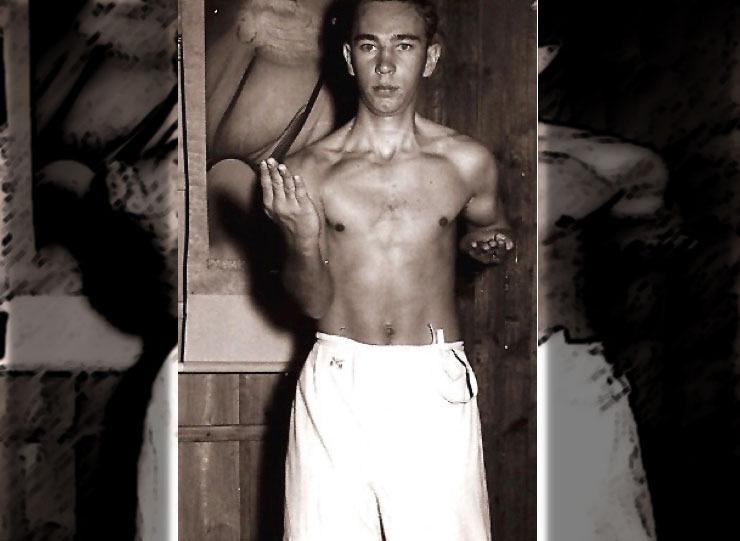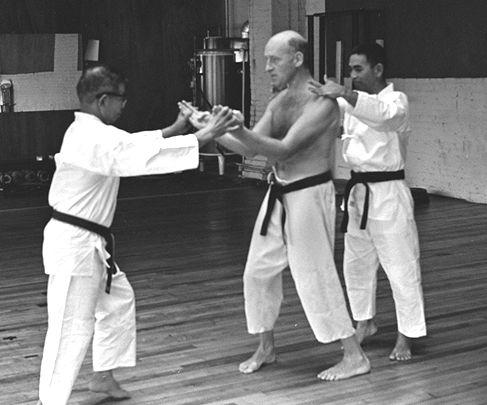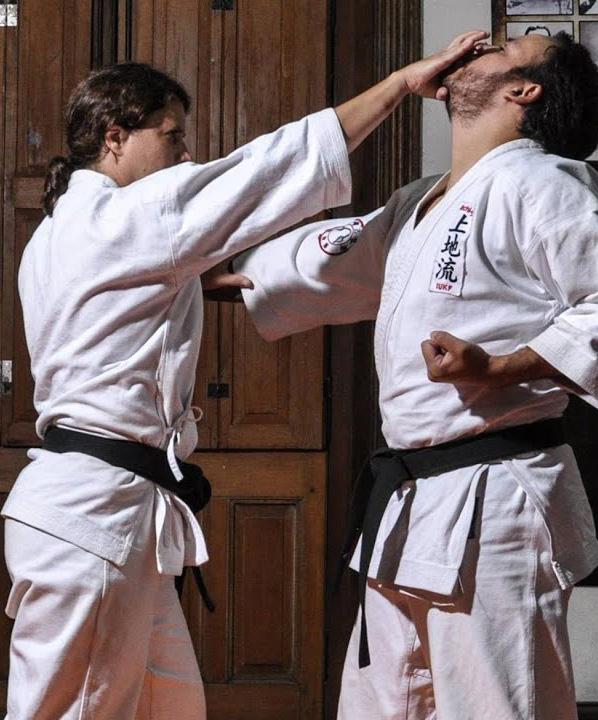
5 minute read
SANCHIN SHIME SENSEI Cecilia Salbuchi
SANCHIN SHIME
Sensei Cecilia Salbuchi
Advertisement
Sanchin Shime
"Everything is in Sanchin" is heard in every Uechi Ryu dojo in the world. They are the words that Kanei Uechi said about the form that gives foundation to our style. Sanchin (lit. three conflicts) is meant to unite the practitioner's mind, body and spirit. When this union occurs, the practitioner becomes immovable, infallible, unbreakable. The form, if you dedicate yourself to observing it, is very simple. It lacks complex movements, kicks or flashy elements. It consists of a single stance (sanchin dachi), short steps, and three types of strikes: single finger lunge (sanchin nukite), double lunge (Morote sanchin nukite), and thumb knuckle strikes (Morote boshiken, after wauke). . To be the first form of the style there is nothing simple about it! It is not customary to practice bunkai (analysis) in this way. That it has it, it has it... but it is not what moves us to practice it. If we study Sanchin properly, understanding its principles, we have plenty to practice Sanchin bunkai while we discuss all other forms of the style. That is, Sanchin is in all of Uechi Ryu. What we practice is Sanchin Shime or Sanchin Kitae. We are going to refer to the term Shime that explains more precisely what we are looking for. Shime comes from Shimeru 閉める, which means "close". According to Sensei Ramón Fernandez Cid, Shime Hōhō 閉 め 方法 means "Closing Method", and it is the name used to check the correct execution of Sanchin in Uechi Ryu and Goju Ryu, as well as its "cousin" Naihanchi ( of Shorin Ryu). Much is debated about the correct way to correct or support the student's growth through Sanchin Shime. The exercise does not consist of merely beating the practitioner while executing the kata, that is something that, if any, is only done in exhibitions to impress the spectators. The base of the exercise consists of blows, touches, pressure and pushes who executes at different times. There are different methodologies. I've seen teachers who have a set pattern with a lot of hitting on one side. And on the other, teachers who hit or play very little, but in a totally random way. Both methods aim at the same thing from different angles. The main thing is to understand what is sought by Sanchin. The union of the practitioner. His intention, physical tension, breathing and his technique must go after a single goal: rooting. From there, all of his hits will be lethal and his blocks will reach their full potential. All being united in one direction, and counting the strength of the earth. In the Shime we check the correct position of the head, shoulders and hips (alignment of the spine); correct neck, trapezius and dorsal tension; followed by quick thrusts and touches to the waist, hips, and thighs; to finish with blows or pressures to the lower part of the legs. The hips should swing forward, and the shoulders should compensate for this so that the spine stays straight. In a second check, perhaps letting the practitioner execute a strike and settle down again, we check the kamae (arms are struck or pushed in different directions), we strike the chest and abdomen. We again verify that he maintains a correct balance in his spine. In this check we normally check that the nukite (spear hand) is well formulated, hitting and/or pressing on the fingers to see if they give up or support the position. After all, we are going to hit like that… And in a third we verify the integrity of the base, hitting the legs from the outside and from the inside, checking that the knees are close enough so that the thighs prevent a blow to the genital area, that the tension in them is just right to

offer stability and flexibility as well. From then on everything is repeated in a similar way, although rarely the same. Although "every teacher has his own book", most will agree that who determines how we will do the Sanchin Shime is the student, since we will stop at what he needs to improve, and not what we as teachers want to do. If the student's problem is in the hip and that he has not yet found how to "close" the position, our blows and pushes will be aimed at achieving this task. Always pushing him to the limit of him, so that he identifies and overcomes it. If, on the other hand, his problem is related to the upper part, we will direct our attention to that area and pay extra attention to the arms, chest, abdomen, back, neck. Touching different points of the body is normally done by digging in the fingers and is a message to adjust that area, for example, by touching the obliques. The push tests the balance, the rigidity, but also the flexibility to absorb and return to the original position. An example of this is when we check the back of the knees with a push with the edge of our foot. And the percussive blow also has a knocking effect, but with the extra complication that now there is a stronger and more tangible combination with breathing, absorption work and kitae itself. The three methods give information to the instructor, but they must give even more information to the practitioner, since it is he who must constantly readjust his body to achieve the task. Let us always remember the final intention of the exercise: to achieve a good Sanchin. Learn to close, root, unite. And the practitioner who achieves it can receive blows of different intensity without being disarmed, surprised or destabilized. An interesting point that is debated is whether to always execute the same order of blows or not. The point in question is related to seeking that the practitioner does not anticipate the movements. For example, if we are going to hit him in the abdomen, he should not lean his body forward in an attempt not to fall later due to the impact. The key is to focus on the final objective and apply it to the entire practice, since even while always doing the same thing, the important thing is that the practitioner incorporates the idea of not anticipating (even in tai kitae or yakusoku kumite) in order to work proper timing. These subtleties are accompanied by the breath of the constant search for the "half hard, half soft" that Uechi Ryu carries in its DNA (the ancestor of Uechi Ryu is Pangainoon, which means that, the same as the meaning of Goju Ryu, another practicing style). of Sanchin). And as a closing, a personal recommendation: The practice of these exercises can hurt, but never hurt. The conditioning of the body must be progressive, constant, disciplined. There is no benefit to beating a novice hard, it is years of work that never ends.











